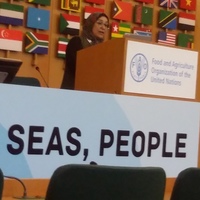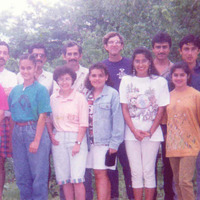Papers by Sam Paul Mathew
Journal of the Bombay Natural History Society, 2001
Journal of the Bombay Natural History Society, 1992
Nelumbo : Bulletin of the Botanical Survey of India, Jul 31, 2019
Eugenia mooniana Wight is reported here for the first time from Andaman and Nicobar Islands, earl... more Eugenia mooniana Wight is reported here for the first time from Andaman and Nicobar Islands, earlier known only from mainland India and Sri Lanka. It also constitutes a new generic record for Andaman and Nicobar Islands. Morphological description of the species along with information on its habitat, ecology, flowering period and distribution is given here.
Journal of the Bombay Natural History Society, 1992

Mimusops andamanensis King and Gamble is an insular taxon with disjunct geographical distribution... more Mimusops andamanensis King and Gamble is an insular taxon with disjunct geographical distribution confined to Sri Lanka and Andaman-Nicobar Islands, enlisted as critically endangered in IUCN red list of threatened plants as well as in the world list of threatened trees. This species is originally described by King and Gamble in 1906 from the Andaman Islands in the Bay of Bengal based on a specimen collected in 1892 by one of the King’s Collectors from South Andamans. Interestingly, this taxon has no further reports from the Andaman-Nicobar Islands and thought to be extinct from its insular habitats until the recent collection in 2014 by the senior author from Little Andaman Island. Extensive and intensive exploration of the island had resulted to locate three solitary trees, within an area of one sq. km., bearing ripened fruits. Surprisingly, no seedlings have been found at the vicinities of these trees or elsewhere. It indicates the natural regeneration of the species has been curtailed. In this context, ripened fruits were gathered to carry out experiments on ex-situ germination studies. A detailed perusal of literature revealed that no reports on seed germination studies of this species have so far been carried out. The experiment was conducted under controlled environmental conditions subjected to a period of 30 days in seed germinator. We have obtained a successful germination rate of 50% at the end of the experiments. The ex-situ conservation of M. andamanensis at the field gene bank of JNTBGRI is a hallmark in genetic conservation of insular endemics and RET plant species of the Andaman-Nicobar Archipelago outside the islands, on account of the recent tsunami in 2004. This is the pioneer documentation with illustrations on seed germination studies of M. andamanensis, the critically
The Indian Forester, Mar 1, 1995
The present paper accounts Jor the re-discovery of Cryptocarya caesia BI. After 73 years from Mt.... more The present paper accounts Jor the re-discovery of Cryptocarya caesia BI. After 73 years from Mt. Harriet hill ranges, South Andamans.
Journal of the Bombay Natural History Society, 1995

Proceedings of the National Academy of Sciences, India, Section B: biological sciences, Feb 28, 2019
An efficient micropropagation protocol has been developed through nodal explant by suppressing ap... more An efficient micropropagation protocol has been developed through nodal explant by suppressing apical dominance for the enhanced production of multiple shoots by the physical method for the first time in Piper sarmentosum. Shoot regeneration was induced from the nodal explant on MS medium supplemented with varying concentrations and combination of different cytokinins (BA, KIN, and 2-ip) and auxins (IAA, IBA, and NAA). Of the different cytokinins used, higher number of the shoots (6.23 ± 0.13) and the higher shoot length (6.27 ± 0.17 cm) were observed on MS medium with 4.44 lM BA. But a remarkable increase in multiple shoots produced when suppressing the apical dominance by the physical method in the optimal concentration of 4.44 lM BA was observed, and this is the first report in tissue culture study. Rhizogenesis was observed on MS medium supplemented with IBA 4.9 lM and plantlets so obtained were hardened and the plant was established successfully on the natural environment with the survival rate of 89.68%. The present protocol suggests that by suppressing the apical dominance through the physical method without any expensive chemicals in the tissue culture system, shoot regeneration percentage can be increased, so we can adopt this method in tissue culture system for the production of a huge number of plants having strong apical dominance.
Journal of Non-timber Forest Products, Mar 1, 2011
Ixora polyantha Wt. (Rubiaceae) is a rare, endemic species of the Western Ghats with high potenti... more Ixora polyantha Wt. (Rubiaceae) is a rare, endemic species of the Western Ghats with high potential ornamental value. The fruit setting in this taxon is found to be rather infrequent when compared with other wild species of Ixora may probably be the reason for its rarity. The paper discusses the various experiments and results carried out in clonal propagation of the species.
Journal of Threatened Taxa, Feb 26, 2013
to 30µm in diameter; ascospores, conglobate, 1-septate, constricted at the septum, 17-20x7-10 µm,... more to 30µm in diameter; ascospores, conglobate, 1-septate, constricted at the septum, 17-20x7-10 µm, wall smooth. Hofmann & Piepenbring (2008) showed the connection between Mahanteshamyces (Hosag.) and Asterina Lév. The former genus is an anamorph of the latter. The present collection reveals both anamorph and teleomorph in the same
Journal of Non-timber Forest Products, Dec 1, 2005
Cinnamomum heyneanum Nees, an endemic wild relative of commercial Cinnamon, confined only to type... more Cinnamomum heyneanum Nees, an endemic wild relative of commercial Cinnamon, confined only to type collection from Karnataka State and thought to be extinct until the recent rediscovery after 185 years from the evergreen forests of Kerala. The present article discusses the ex situ conservation of this critically endangered Lauraceous aromatic species through field gene bank of the Tropical Botanic Garden and Research Institute (TBGRI) and successful clonal multiplication through air layering for further advance research and bioprospecting of the same.
Indian journal of forestry, Dec 1, 2012
Syzygium megacarpum (Craib) Rathakr. & N.C. Nair, a wild myrtaceous tree species, is ... more Syzygium megacarpum (Craib) Rathakr. & N.C. Nair, a wild myrtaceous tree species, is described along with photographs as a new distributional record for Andaman-Nicobar Islands.
TAPROBANICA: The Journal of Asian Biodiversity, Jun 21, 2013
The International Palm Society, 2001
Indian Journal of Forestry, 2012
Syzygium megacarpum (Craib) Rathakr. & N.C. Nair, a wild myrtaceous tree species, is described al... more Syzygium megacarpum (Craib) Rathakr. & N.C. Nair, a wild myrtaceous tree species, is described along with photographs as a new distributional record for Andaman-Nicobar Islands.
Nelumbo, 2019
Eugenia mooniana Wight is reported here for the first time from Andaman and Nicobar Islands, earl... more Eugenia mooniana Wight is reported here for the first time from Andaman and Nicobar Islands, earlier known only from mainland India and Sri Lanka. It also constitutes a new generic record for Andaman and Nicobar Islands. Morphological description of the species along with information on its habitat, ecology, flowering period and distribution is given here.
Journal of the Bombay Natural History Society, 1994











Uploads
Papers by Sam Paul Mathew